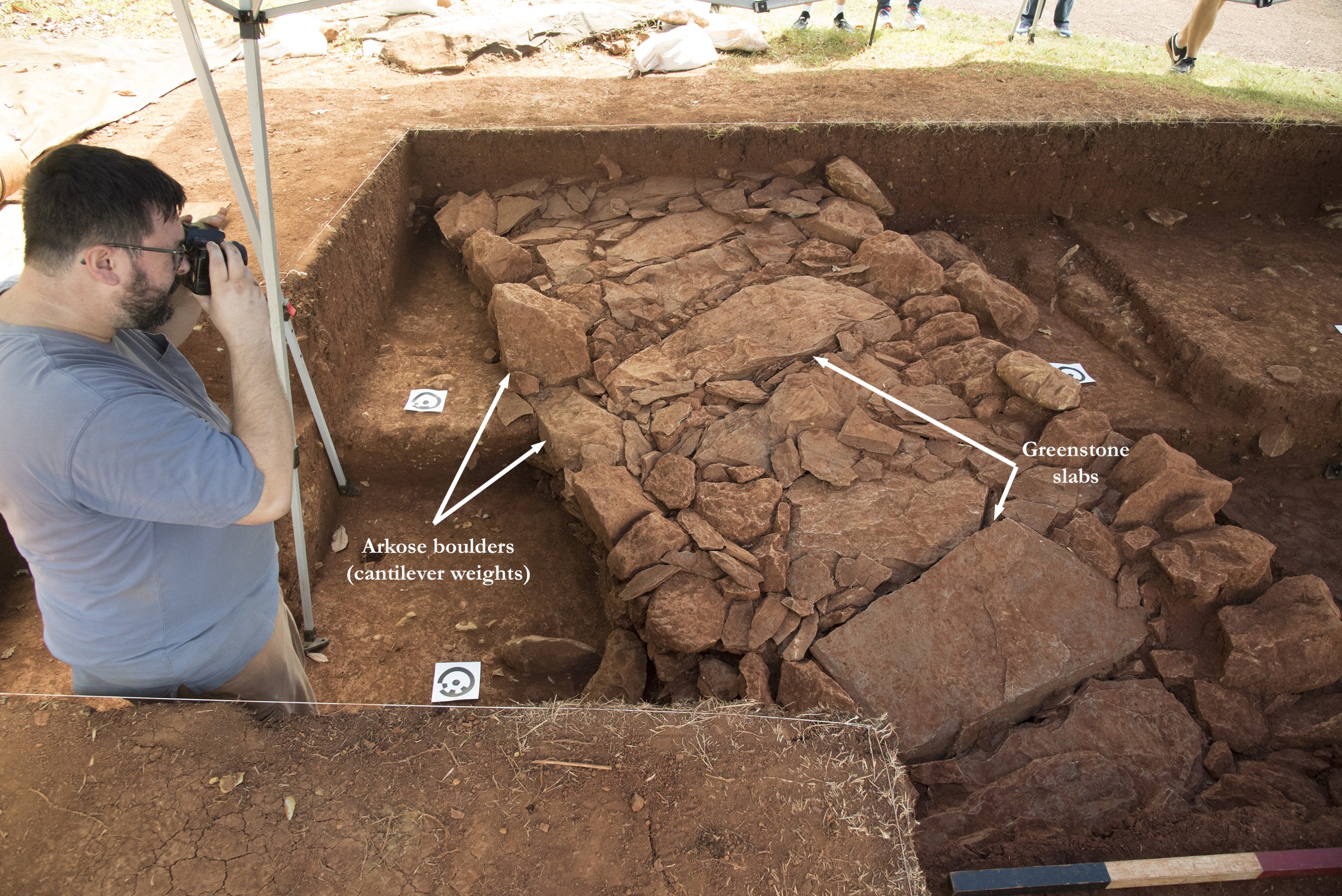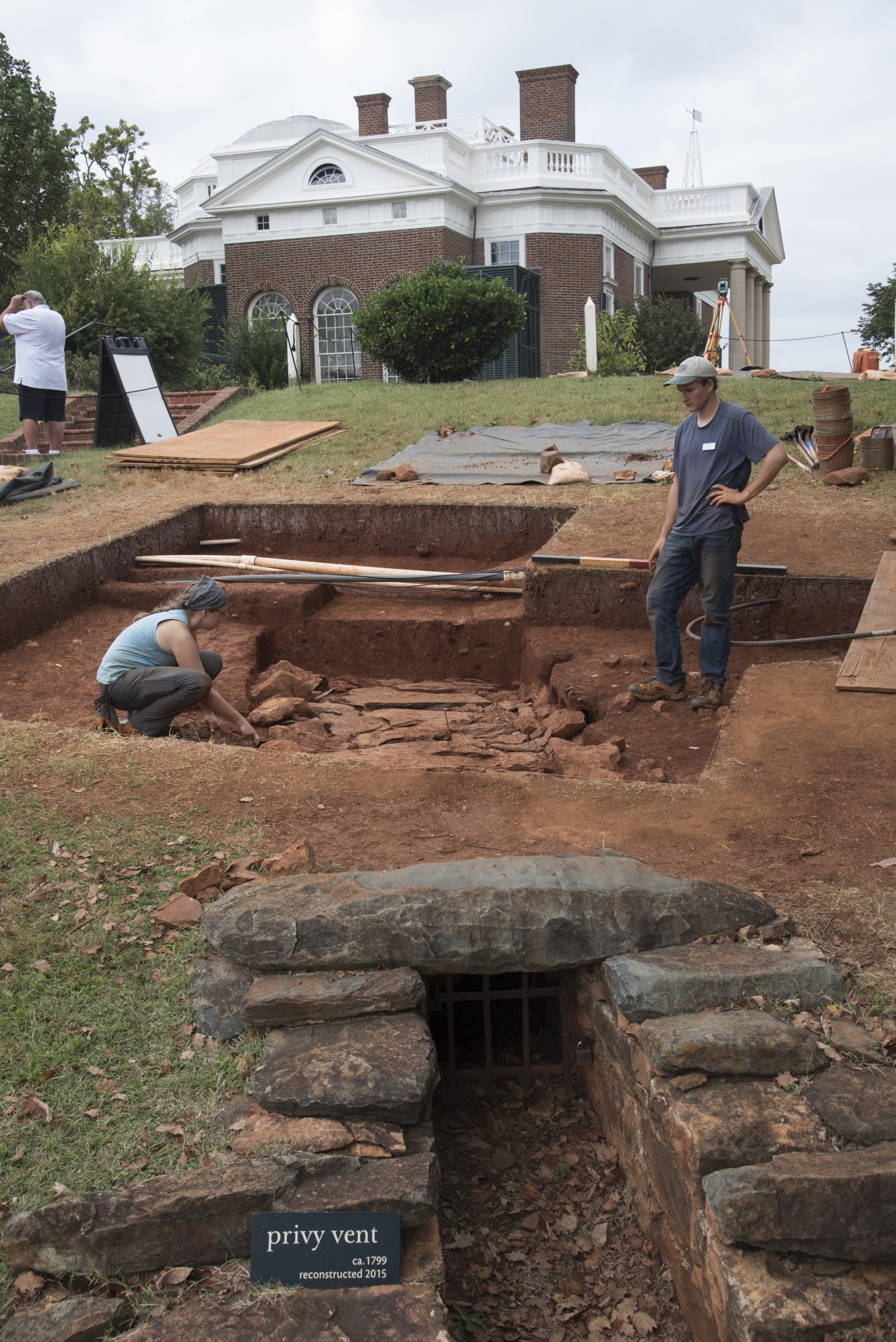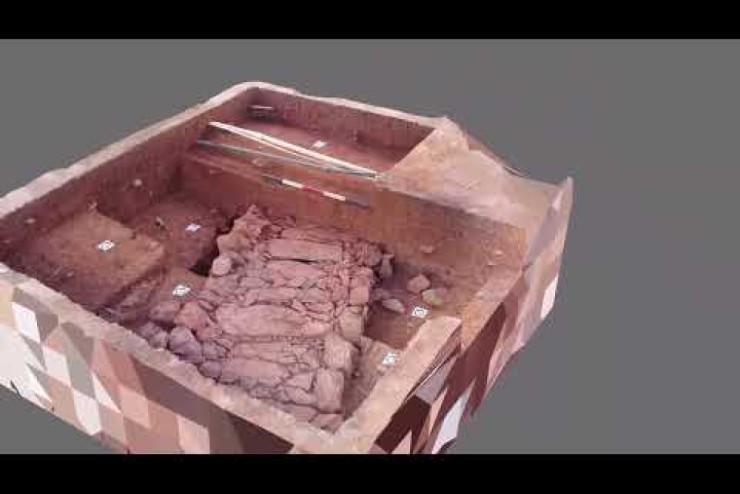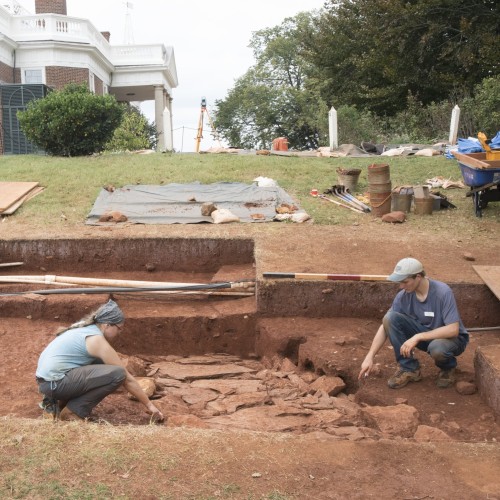Monticello's archaeologists, led by Field Research Manager Crystal O'Connor, have exposed a 10-foot section of a 150-foot-long masonry tunnel that runs under the East Lawn (Figure 1). Jefferson designed the tunnel to pull fresh air from its open southern end, near Mulberry Row, into the vertical shafts for three privies that he had built into Monticello II, the second version of the mansion. We think that Jefferson's goal was to mitigate the olfactory costs of his decision to build privies inside the house.

Figure 1: Archaeologist Craig Kelley photographs the top of the East Lawn privy tunnel. The paper targets, whose locations in 3-d space are known, will allow more accurate construction, from hundreds of photos, of a 3-d model of the tunnel and our excavation, using "structure from motion" photogrammetric software (see movie at bottom for full rendering). See the text for explanation of the engineering choices represented by the greenstone slabs and arkose boulders.
Our excavations have allowed us to examine more closely the rocks comprising the privy tunnel and the way they were assembled. We do not know the identities of the masons who built the tunnel. Given the large scale of the project, they were almost certainly both free and enslaved workers. However, we have been able to puzzle out how they used their skills and knowledge of materials afforded by the local geology to achieve Jefferson's goal. The deep geological history of Monticello Mountain is a key part of the story.
The privy tunnel is constructed from two kinds of rock: greenstone and arkose. Masons used arkose to build the walls of the tunnel and greenstone to build the roof (Figure 2). Why? Their choices were shaped by the local geology, the fracture mechanics of the two kinds of rock, and the tectonic forces that shaped both over the past 600 million years.

Figure 2: A view inside the 150-foot-long privy tunnel. Masons use arkose blocks to build the interior walls. Greenstone slabs, placed on top of the blocks, partially extend over the 2.5-foot gap between the walls. They serve as cantilevers that support a second set of greenstone slabs covering the remaining gap.
Greenstone is the parent material underlying the Southwest Mountains, including Monticello Mountain. Greenstone is metamorphosed basalt. In the Monticello case, the basalt initially erupted over 500 million years ago during a rifting event that pulled apart an early supercontinent called Rodinia and created a proto-Atlantic Ocean. The lava flows were hundreds of feet thick. Further rifting opened cracks in the cooled basalt into which were deposited sands and silts eroding from nearby granitic rocks of the continental interior to the west. These rocks were also exposed by the rifting process. Luckily for Jefferson, a large crack opened at the base of what would millions of years later become Monticello Mountain. The erosion deposits that filled the crack are the source of the arkose.
Fast forward 200 million years. The African and North American continents collided to create the supercontinent Pangea. The collision pushed up the Southwest Mountain chain, as well as the Alleghenies farther west. The pressure and heat created by the collision metamorphosed the basalt into greenstone (or "metabasalt"). Over the ensuing millions of years, weathering of the exposed greenstone has created deep, clay-rich soil overlying greenstone bedrock. The soil profile contains partially weathered greenstone cobbles and boulders. The continental collision also metamorphosed the sand and silt eroded into the cracks in the basalt into arkose (or "arkosic sandstone").
Because of their different geological origins, these two rock types have very different fracture mechanics, which the masons working at Monticello recognized and used to their advantage. Arkose is comprised of quartz and feldspar grains, later cemented together. It fractures predictably along relatively flat planes in all directions, making it easy for the masons to shape the irregular boulders quarried from an arkose vein at the base of Monticello Mountain into rectangular blocks. The holes drilled for black powder charges used to blast the boulders out of the massive arkose deposit are still visible at the quarry site today.
Its igneous origins make greenstone a more challenging raw material. By far, most of the greenstone cobbles and boulders that we have encountered in our excavations at Monticello were metamorphosed at low heat and temperatures. They retain the homogenous structure of the original basalt. This means they fracture conchoidally, along curved surfaces, making it very difficult to shape them into rectangular blocks. Masons at Monticello therefore regularly used low-grade metabasalt cobbles and boulders in unmodified form in the dry-laid foundations of log buildings, for example, slave cabins on Mulberry Row.
However, the masons who built the tunnel were able to find a zone of greenstone metamorphosed at high temperature and pressure that caused the formation of mineral crystals which aligned perpendicular to the pressure. The resulting foliation created parallel cleavage planes running in a single direction. This made it easier to split larger rocks along those planes, but difficult to shape flat surfaces perpendicular to them. While high-grade metabasalt could not easily be shaped into blocks, it could be split into slabs with flat, parallel upper and lower surfaces and irregular edges. The masons recognized these properties and took advantage of them when they built the tunnel.
We do not know where the masons found these high-grade metabasalts. One possibility is that they encountered them deep in the soil profile as enslaved workers dug the cellar, the covered passages, and the wings for Monticello II. The lack of weathering on the metabasalt used in the tunnel is consistent with this hypothesis.

Figure 3: Overall view of the excavation area with the privy vent tunnel. Archaeological field techs Alyssa Baker and Luke Arcement clean off the greenstone slabs capping the tunnel.
Drawing stratigraphic evidence from the rocks comprising the tunnel and the layers of sediment surrounding it, we can assemble the following hypothesis about the construction process and the choices made by the masons. Stratigraphy established that the first step was digging a deep trench through up to five feet of sediment that enslaved workers had excavated for the Monticello II cellars, covered passages, and wings and carefully sculpted to create the level East Lawn we see today. In this trench, the masons used dry-laid arkose blocks to build the interior walls. Each wall was a single block thick. To add strength to the block walls against soil pressure and to improve drainage, workers laid up unshaped cobbles and boulders among their exteriors, creating walls that were roughly 1.7 feet thick. These rocks were mostly arkose, but a few weathered, low-grade metabasalts were used as well.
The masons were now faced with the problem of roofing over the 2.5-foot gap between the walls. High-grade metabasalt, split into slabs from .3 to .5 feet thick, offered part of the solution. However, most of the slabs were not long enough to bridge the gap.
To solve this problem, the masons devised a clever cantilever system (Figure 2). The cantilevers were greenstone slabs placed on top of each wall. One end of each slab aligned with the wall exterior. The other end partially extended over the original gap, leaving a smaller one. The masons then bridged the smaller gap with another greenstone slab. To keep the cantilevers from collapsing into the original gap, the masons weighted down their outward-facing ends with unshaped arkose boulders (Figure 1). Because the edges of the metabasalt slabs were so irregular, there were still small gaps between them. The masons filled these with smaller, thinner metabasalt slabs, creating a continuous roof. They then backfilled the builder's trench.
Their engineering choices have stood the test of over two centuries. Like most of Monticello's buildings and landscapes, the privy tunnel depended not only on Jefferson's designs but on the practical skills and knowledge of the craftsmen who built it—enslaved and free alike.
Acknowledgements
Archaeology is an essentially interdisciplinary and collaborative discipline. Thank you to three geologists whose local research is featured here: the late Professor Cullen Sherwood (James Madison University), Professor Chuck Bailey (William and Mary), and especially Professor Callan Bentley (Piedmont Valley Community College). We are also grateful to James Zehmer, Monticello's Director of Restoration, a valued partner solving architectural puzzles.

Video of a 3D model of the exposed portion of the privy vent tunnel. By Craig Kelley

